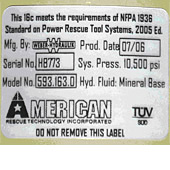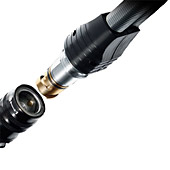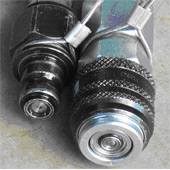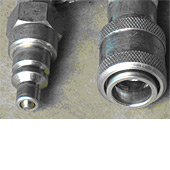Rescue EquipmentHydraulic Rescue ToolsCouplings Compatibility
Genesis Tool CompatibilityAs can be seen in our NFPA label in the picture to the left, our maximum system pressure is 10,500 psi, and we use mineral based hydraulic fluid. Genesis Rescue Tools are compatible with other rescue tools that use the same fluid, max pressure, and couplers. Available Coupling Types
Genesis OSC (One Step Coupler)The new Genesis “One Step Coupler” allows for tools to be disconnected and reconnected, without a person returning to the pump’s “dump valve” to relieve pressure. It is “hot swappable”. Our large OSC coupling is very durable and will not fail if inadvertently disconnected while the tool is being used. Older “twin-line” systems of Genesis (and other) manufacture can be easily upgraded to the One Step Coupler. This maintains compatibility with older systems. Another advantage of our OSC coaxial coupler is that it uses conventional twin-line hose…this reduces costs of upgrading. To Connect: Push male and female couplings together while twisting the slide covering the female coupler until it locks in place. To Disconnect: Reverse the connection process. 
Cejn Flat Face Couplings(Compatibility: Holmatro Twin-Line Tools) At Santiam Emergency Equipment, the Cejn flat-face female coupling style is our favorite twin-line coupling. This is one of the optional couplings for Genesis Rescue Tools, and the ones we have on our demo equipment. To Connect: Simply push the two couplings together and they automatically lock in place. To Disconnect: Twist the slide covering the female coupler 1/8-turn and push it towards the back. 
Parker Coupling(Compatibility: Amkus Rescue Tools) The Parker coupler is an optional coupler for Genesis Rescue Tools. To Connect: Ensure the lock/slide on the female coupler is open (ensure the pin lines up with the slot), and then push the slide towards the back. Slide the male coupling in and let go of the slide. Twist the slide so that the pin does not line up with the slot (locking it). To Disconnect: Twist the slide covering the female coupler so that the pin lines up with the slot and then push it towards the back. |
|
